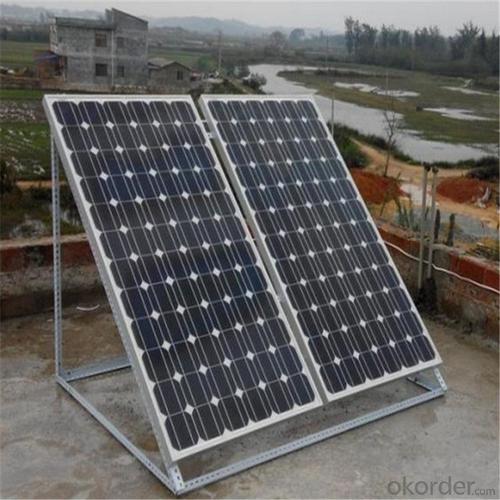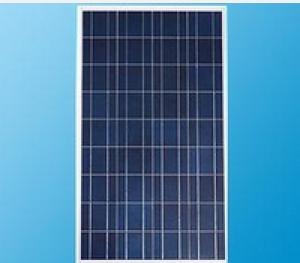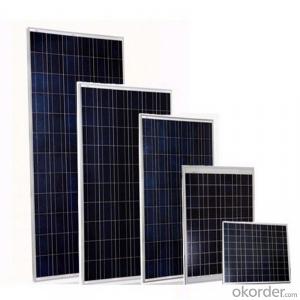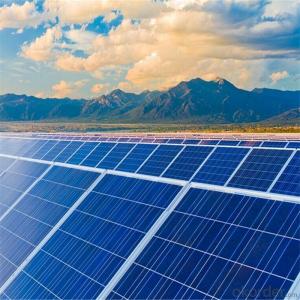250 Watt Photovoltaic Poly Solar Panel supplier
- Loading Port:
- China main port
- Payment Terms:
- TT or LC
- Min Order Qty:
- 1000 watt
- Supply Capability:
- 500000 watt/month
OKorder Service Pledge
OKorder Financial Service
You Might Also Like
Specification
Instruction
Quality and Safety
1. Rigorous quality control meets the highest international standards.
2. High-transmissivity low-iron tempered glass, strong aluminium frame.
3. Using UV-resistant silicon.
4. IS09001/14001/CE/TUV/UL
5.3w-300w mono & poly solar panel supply
Warranties
1. 10 years limited product warranty
2. 15 years at 90% of the minimal rated power output
3. 25 years at 80% of the minimal rated power output
Feature
1. High efficiency and High power.
2. Long-term electrical stability.
3. Lowest price and Fastest delivery.
4. Good quality and good service.
5.Bulk supply
6. Good Warranty
7.Big Sale
8.High quality
9.More than 35 years on the lifetime.
10 DHL/Fedex/UPS/TNT/EMS etc
Images
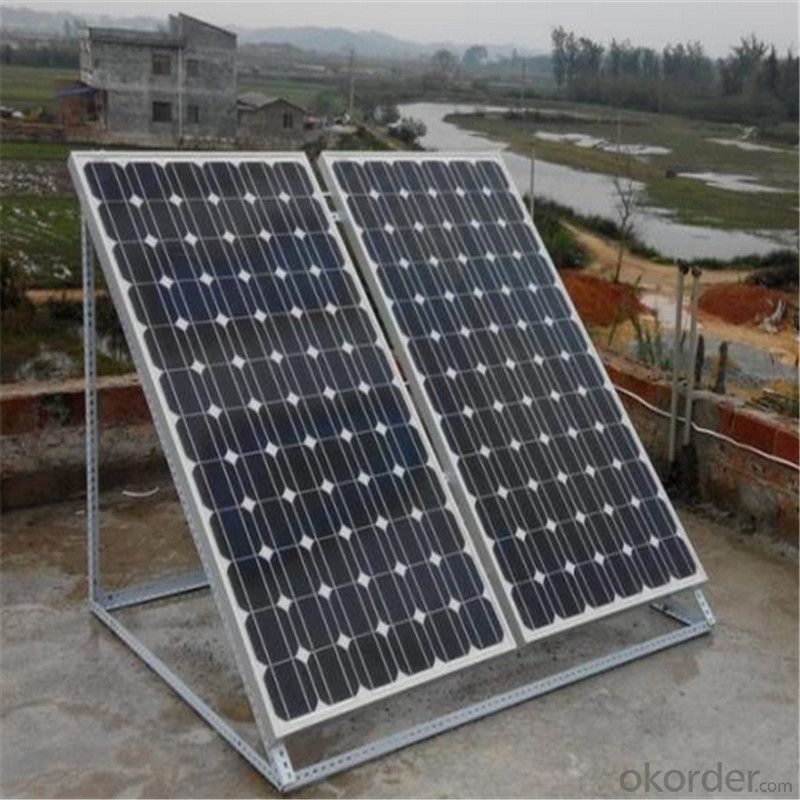

Specification
Model | SIM-100 |
Maximum Power at ST(Pmax)W | 100Wp |
Maximum Power Voltage(Vmp)V | 18.0V |
Maximum Power Current(Imp)A | 5.56A |
Open Circuit Voltage(Voc)V | 22.0V |
Short Circuit Current(Isc)A | 5.9A |
Cell Efficiency(%) | 17.0% |
Module Efficiency(%) | 15.37% |
Operating Temperature°C | -40°C to 85°C |
Maximum system voltage | 1000V(IEC)DC |
Power tolerance | -0.03 |
Temperature coefficients of Pmax | -0.45%/°C |
Temperature coefficients of Voc | -0.27%/°C |
Temperature coefficients of Isc | 0.05%/°C |
Weight(kg) | 7.4 |
Number of cell(pcs) | 4*9 |
FAQ
We have organized several common questions for our clients,may help you sincerely:
1). What’s price per watt?
A: It’s depends on the quantity, delivery date and payment terms of the order. We can talk further about the detail price issue. Our products is high quality with lower price level.
2). Can you tell me the parameter of your solar panels?
We have different series of cells with different power output, both from c-si to a-si. Please take our specification sheet for your reference.
3). How do you pack your products?
We have rich experience on how to pack the panels to make sure the safety on shipment when it arrives at the destination.
4). How long can we receive the product after purchase?
In the purchase of product within three working days, We will arrange the factory delivery as soon as possible. The perfect time of receiving is related to the state and position of customers. Commonly 7 to 10 working days can be served.
How do solar cells work?

A solar cell is a sandwich of n-type silicon (blue) and p-type silicon (red). It generates electricity by using sunlight to make electrons hop across the junction between the different flavors of silicon:
When sunlight shines on the cell, photons (light particles) bombard the upper surface.
The photons (yellow blobs) carry their energy down through the cell.
The photons give up their energy to electrons (green blobs) in the lower, p-type layer.
The electrons use this energy to jump across the barrier into the upper, n-type layer and escape out into the circuit.
Flowing around the circuit, the electrons make the lamp light up.
Principles of the working about solar cells
Solar cells convert the sun’s energy into electricity. Whether they’re adorning your calculator or orbiting our planet on satellites, they rely on the the photoelectric effect: the ability of matter to emit electrons when a light is shone on it.
Silicon is what is known as a semi-conductor, meaning that it shares some of the properties of metals and some of those of an electrical insulator, making it a key ingredient in solar cells. Let’s take a closer look at what happens when the sun shines onto a solar cell.
Sunlight is composed of miniscule particles called photons, which radiate from the sun. As these hit the silicon atoms of the solar cell, they transfer their energy to loose electrons, knocking them clean off the atoms. The photons could be compared to the white ball in a game of pool, which passes on its energy to the coloured balls it strikes.
Freeing up electrons is however only half the work of a solar cell: it then needs to herd these stray electrons into an electric current. This involves creating an electrical imbalance within the cell, which acts a bit like a slope down which the electrons will flow in the same direction.
Creating this imbalance is made possible by the internal organisation of silicon. Silicon atoms are arranged together in a tightly bound structure. By squeezing small quantities of other elements into this structure, two different types of silicon are created: n-type, which has spare electrons, and p-type, which is missing electrons, leaving ‘holes’ in their place.
When these two materials are placed side by side inside a solar cell, the n-type silicon’s spare electrons jump over to fill the gaps in the p-type silicon. This means that the n-type silicon becomes positively charged, and the p-type silicon is negatively charged, creating an electric field across the cell. Because silicon is a semi-conductor, it can act like an insulator, maintaining this imbalance.
As the photons smash the electrons off the silicon atoms, this field drives them along in an orderly manner, providing the electric current to power calculators, satellites and everything in between.
- Q: Can solar cells be used in satellite or space exploration missions?
- Yes, solar cells can be used in satellite or space exploration missions. Solar cells are an efficient and reliable source of electricity that can harness the energy from the Sun in space. They are commonly used in satellites and space probes to power various systems and instruments, as they can generate electricity even in the absence of an atmosphere. Additionally, solar cells offer a lightweight and compact solution for power generation in space, making them ideal for long-duration missions where other power sources may not be feasible.
- Q: Can solar cells be used to power remote locations?
- Yes, solar cells can be used to power remote locations. Solar cells, also known as photovoltaic cells, convert sunlight into electricity. They can be installed in remote areas where there is no access to the grid or where it is not feasible to connect to the grid. Solar power is a sustainable and renewable energy source, making it an ideal solution for powering remote locations that are off the grid.
- Q: Can a solar cell be used in commercial buildings?
- The answer is absolutely yes!
- Q: How do solar cells perform in areas with high levels of chemical pollutants?
- Solar cells may not perform optimally in areas with high levels of chemical pollutants. The presence of pollutants in the air can reduce the amount of sunlight reaching the solar cells, thereby decreasing their efficiency and power output. Additionally, chemical pollutants may accumulate on the surface of the solar cells, leading to the formation of a layer that can block sunlight absorption. Regular cleaning and maintenance of the solar cells becomes crucial in such areas to mitigate the impact of chemical pollutants on their performance.
- Q: Can solar cells be used in security systems?
- Yes, solar cells can be used in security systems. Solar-powered security systems utilize solar cells to convert sunlight into electricity, which is then stored in batteries to power the system. This allows for independent operation and eliminates the need for a constant power supply or wiring, making solar-powered security systems an efficient and sustainable choice.
- Q: I bought a new poly solar cells, and the test result of the conversion efficiency is 16.8%, is it lower than usual?
- It depends on what kind os poly solar cell you are using, if it is 260 watt photovoltaic solar panel, 16.8% is a bit lower.
- Q: Can solar cells be used on road surfaces?
- Yes, solar cells can be used on road surfaces. Solar road technology, also known as solar roadways, involves embedding solar panels into roadways to generate electricity. These solar panels are designed to withstand the weight of vehicles and can be used to power streetlights, traffic signals, and even electric vehicles. However, there are challenges to overcome, such as durability and cost-effectiveness, before widespread implementation can occur.
- Q: What is the solar cell?
- When the surface of the solar cell and the electrode on the back side are connected with each other, a current flows.
- Q: Can solar cells be used for powering offshore oil rigs?
- Yes, solar cells can be used for powering offshore oil rigs. They provide a sustainable and reliable source of energy, reducing the reliance on fossil fuels and minimizing the environmental impact. Additionally, advancements in solar technologies have made them more efficient and capable of withstanding harsh offshore conditions, making them a viable option for offshore oil rig power generation.
- Q: Where can I get the most accurate information about solar cells?
- Maybe your teacher can give you some suggestions.
Send your message to us
250 Watt Photovoltaic Poly Solar Panel supplier
- Loading Port:
- China main port
- Payment Terms:
- TT or LC
- Min Order Qty:
- 1000 watt
- Supply Capability:
- 500000 watt/month
OKorder Service Pledge
OKorder Financial Service
Similar products
Hot products
Hot Searches
Related keywords


